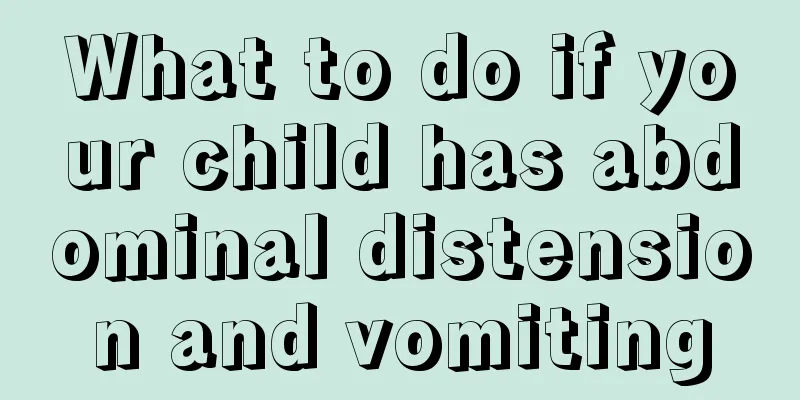What to do if your child has abdominal distension and vomiting

|
It is very common for children to have abdominal distension and vomiting. Parents usually feel particularly anxious when their children vomit and will randomly give them some stomach medicine. In fact, there are many reasons for vomiting. Parents should take their children to the hospital for a detailed examination and should not use medicine at will according to their own judgment. So what should children do when they have abdominal distension and vomiting? Abdominal distension and vomiting are common occurrences in children. When parents encounter this situation, they don’t know what to do in a hurry. In fact, when children have abdominal distension and vomiting, parents need to master the correct treatment methods to avoid accidents. So, what should we do if children have abdominal distension and vomiting? 1. Let the child sit up and turn his head to one side to prevent vomit from entering the trachea. 2. After vomiting, rinse your mouth with warm water to clean your mouth and remove odor. Babies can clean their mouths by feeding them water frequently. 3. Feed water frequently, drink small amounts frequently, and ensure water supply to prevent excessive water loss and dehydration. The water temperature should be hotter in winter and cooler in summer. Warm water can easily cause vomiting. 4. Pay attention to your diet, don’t eat too much, and try to eat small meals frequently. Do not eat greasy, spicy or sour foods to avoid irritating the stomach and intestines. After vomiting, you should first eat liquid food or semi-liquid food (such as rice porridge or noodles), and gradually transition to a normal diet. 5. Pay attention to the vomiting situation, the relationship between vomiting, diet and coughing, the number of vomiting, the vomited stomach contents, etc. 6. Try to rest in bed and avoid changing your body position frequently, otherwise it will easily cause vomiting again. 7. Vomiting in children is often caused by digestive dysfunction. Therefore, when a child vomits, the first thing to do is to temporarily fast to allow the digestive tract to have some rest. You can first give the child some light sugar salt water or light tea, and the child will be fine after a few hours or 1 to 2 days. 8. If the baby occasionally vomits after feeding, it may be that he has swallowed air. The nipple should be blocked during the next feeding to prevent the baby from swallowing air. After sucking, you can hold the baby and pat his back to let the air out. Then lie on the right side with the upper body slightly raised. If the child often vomits after sucking milk but is generally normal, he may have pyloric spasm. Under the guidance of a doctor, the child should be given some antispasmodics. When the general nutritional status is affected, pyloric hypertrophy should be prevented and a doctor should be asked to check. 9. If severe vomiting occurs repeatedly, including spitting out yellow water, and general care does not improve, you should be careful of intestinal obstruction. If accompanied by other conditions such as fever, the details should be reported to the doctor. If you find that the vomitus is abnormal, you should bring it to your doctor so that the doctor can analyze the cause of the vomiting and deal with it promptly and correctly. The above is an introduction to what to do if children have abdominal distension and vomiting. When a child has abdominal distension and vomiting, the first thing to do is to help the child clean up the vomit to prevent it from choking into the trachea and causing discomfort. Secondly, observe the child's vomiting and let the child rest more. If the vomiting is severe, it is recommended to seek medical treatment in time. |
<<: Symptoms of abdominal distension in full-month baby
>>: Can a hernia in a child heal on its own?
Recommend
Symptoms of language communication disorders in infants
Often when a child is young, it is difficult for ...
What is the reason for the red pimples on the child's body?
Once a child develops a skin disease, it always g...
Can I squeeze the abscess on my child's leg?
Sometimes, we can always see some pustules on our...
What's wrong with a child having a low fever and sweating?
Low-grade fever is a relatively common disease at...
What causes separation anxiety in children?
The main reason for separation anxiety in young c...
White spots on the child's skin
Children with fair skin are very attractive. Many...
What to do if your 6-year-old child is disobedient
There is no child who is not annoying. Although p...
Does your child have a lump in his breast? These issues cannot be ignored
With the improvement of living standards, many pr...
What should I do if my child falls on his head and gets a big bump?
We all know that children are lively and active b...
Why is my five-month-old baby crying in the middle of the night?
We know that good sleep is directly related to th...
How many months does it take for a baby to straighten its legs?
When a baby is born in the family, parents will g...
What are the symptoms of intellectual disability in children?
When children's bodies are developing and sho...
What causes motion sickness in children?
Although motion sickness is not a real disease, i...
What are the correct sleeping positions for newborns?
For newborn babies, everything is new, because it...
Is neonatal arrhythmia serious?
Arrhythmia is a very common disease in life. Most...









